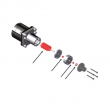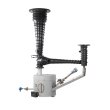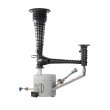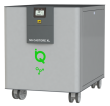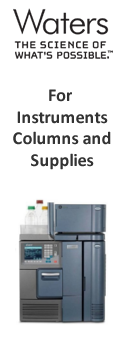Description : Recombinant Human Tumor Necrosis Factor α (rhTNF-α) Catalog# Quantity Lot# TN1001-100 100 μg 0701 Source: Recombinant human protein expressed in E. coli. Formulation: Powder lyophilized from phosphate-buffered saline (PBS) Preservative: None. MW: 17 kDa Purity: >97% (15% SDS-PAGE) Sterility: 0.2 μm membrane-filtered and packaged aseptically. ED50*: 0.01 - 0.1 ng/ml. Endotoxin: ≤0.1 EU/_g TNF-α, as determined by Limulus Amebocyte Lysate (LAL) assay QC Tests: SDS-PAGE, Native PAGE, ELISA, TC Reconstitution and Use: Reconstitute the contents of the vial using sterile phosphate-buffered saline (PBS) to a concentration no less than 100 μg/ml and aliquot for future use. (If the initial rehydration is too dilute, activity may be lost due to the non-specific adsorption to the container). The solution can then be further diluted to a working stock solution. Bovine serum albumin can be added to the working solution to protect TNF-α from loss at low concentrations. Storage and Stability: Upon receiving, store the product at -20°C. After reconstitution, store the working aliquots at 2-8 °C for no more than 3 months. For extended storage, aliquot the rehydrated solution (≥100 μg/ml) and freeze at -70°C or -20°C. Avoid repeated freezing and thawing. More dilute solutions stored at -20 °C will lose activity faster. *ED50 Assay: The ED50 is defined as the effective concentration of TNF-α that causes 50% cytolysis of murine L929B cells, a TNF-α sensitive mouse fibrosarcoma cell line, in the presence of actinomycin-D. Results may vary depending on cell line used. (Havell, E.A., 1987). About Tumor Necrosis Factor α Tumor Necrosis Factor-Alpha (TNF-α), also known as cachectin, is named after its activity to cause tumor necrosis in vivo when injected into tumor-bearing mice. TNF-α is expressed as a 26 kDa membrane bound protein and is then cleaved by TNF-α converting enzyme (TACE) to release the soluble 17 kDa monomer which forms homotrimers in circulation. Recombinant TNF-α exists as homo-dimer, -trimer or -pentamer. TNF-α is believed to play roles in antitumor activity, immune modulation, inflammation, anorexia, cachexia, septic shock, viral replication and ematopoiesis. TNF-α is expressed in many types of cells but primarily in macrophage cells in response to immunological challenges such as bacteria (lipopolysaccharides), viruses, parasites, mitogens and other cytokines. TNF-α is closely related to the 25 kDa protein Tumor Necrosis Factor-β (lymphotoxin) with 28% amino acid sequence identity, sharing the same receptors (TNFR1 and TNFR2) and cellular actions. TNF-α causes cytolysis or cytostasis of many transformed cells, being synergistic with γ -interferon in its cytotoxicity. Although it has little effect on many cultured normal human cells, TNF-α appears to be directly toxic to vascular endothelial cells. Other actions of TNF-α include stimulating growth of human fibroblasts and other cell lines, activating polymorphonuclear neutrophils and osteoclasts, and induction of interleukin-1, prostaglandin E2 and collagenase production. References: Aggarwal, B., and Reddy, S., Nicola, N., ed., Tumor necrosis factor (TNF) Guidebook to Cytokines and Their Receptors , New York (1994), 103-104 Beutler, B., Sporn, M., and Roberts, A, ed., cachectin/tumor necrosis factor and lymphotoxin Peptide Growth Factors and their Receptors II , New York (1991), 39-70 Ware, C., et al., Thomson, A.W., ed., Tumor necrosis factor-related ligands and receptors. The Cytokine Handbook 3rd ed., , San Diego, CA (1998), 549
- Model: TN1001-100
- Manufactured by: Biomiga






